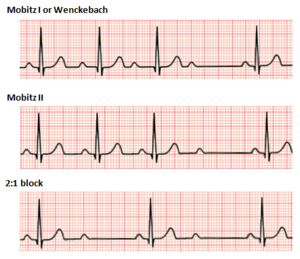Atrioventricular block, second degree
| Second-degree atrioventricular block | |
|---|---|
 |
|
| Classification and external resources | |
| Specialty | Cardiology |
| ICD-10 | I44.1 |
| ICD-9-CM | 426.12, 426.13 |
| DiseasesDB | 10477 |
| eMedicine | emerg/234 |
Second-degree atrioventricular block (AV block) is a disease of the electrical conduction system of the heart. It is a conduction block between the atria and ventricles. The presence of second-degree AV block is diagnosed when one or more (but not all) of the atrial impulses fail to conduct to the ventricles due to impaired conduction. It is classified as a block of the AV node and is categorized in between first-degree (slowed conduction) and third degree blocks (complete block).
Most people with Wenckebach (Type I Mobitz) do not show symptoms. However, those that do usually display one or more of the following:
There are two non-distinct types of second-degree AV block, called Type 1 and Type 2. In both types, a P wave is blocked from initiating a QRS complex; but, in Type 1, there are increasing delays in each cycle before the omission, whereas, in Type 2, there is no such pattern.
Type 1 second-degree heart block is considered a more benign entity than type 2 second-degree heart block with type 1 not having structural changes found on histology.
Both types are named after Woldemar Mobitz. Type I is also named for Karel Frederik Wenckebach, and type II is also named for John Hay.
Type 1 Second-degree AV block, also known as Mobitz I or Wenckebach periodicity, is almost always a disease of the AV node. Wenckebach published a paper in 1906 on progressively lengthening PR intervals that was later classified as Type I in Mobitz's 1924 paper . Thus, both "Mobitz type I" and "Wenckebach block" refer to the same pattern and pathophysiology.
In Wenckebach's 1906 paper, his original observations were from increasing delay in contraction of the atria & ventricles that shortened after a brief pause and this was later observed on ECG after Einthoven's invention in 1901 that became the electrocardiogram (ECG). Today, Mobitz I heart block is characterized by progressive prolongation of the PR interval on consecutive beats followed by a blocked P wave (i.e., a 'dropped' QRS complex). After the dropped QRS complex, the PR interval resets and the cycle repeats. This grouped beating was described as "Luciani periods" after Luigi Luciani's work in 1873 . This results in a shortening of the R-R interval as the earlier P-waves reach an increasingly refractory AV node, which is what ultimately results in the non-conducted / blocked QRS complex.
...
Wikipedia
